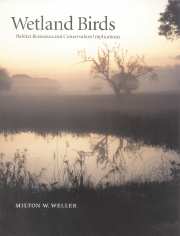Book contents
- Frontmatter
- Contents
- List of plates
- Preface
- Acknowledgments
- 1 Introduction
- 2 Wetlands: what, where, and why
- 3 Major groups of birds that use wetlands
- 4 Water and other resource influences
- 5 Foods, feeding tactics, strategies, and guilds
- 6 Bird mobility and wetland predictability
- 7 Other behavioral and physical influences on wetland living
- 8 Spatial and structural patterns
- 9 Habitat dynamics: water, plant succession, and time
- 10 Population consequences of wetland abundance and quality
- 11 How birds influence wetlands
- 12 Conservation implications
- 13 Measures of bird habitat use and quality
- 14 Current status and some conservation problems
- 15 Conservation and management strategies
- 16 Outlook
- 17 Epilogue
- Appendix 1 Scientific names of birds and bird groups
- Appendix 2 Scientific names of animals and animal groups other than birds
- Appendix 3 Scientific names of plants and plant groups
- Index of birds and bird groups
- Subject index
16 - Outlook
Published online by Cambridge University Press: 02 October 2009
- Frontmatter
- Contents
- List of plates
- Preface
- Acknowledgments
- 1 Introduction
- 2 Wetlands: what, where, and why
- 3 Major groups of birds that use wetlands
- 4 Water and other resource influences
- 5 Foods, feeding tactics, strategies, and guilds
- 6 Bird mobility and wetland predictability
- 7 Other behavioral and physical influences on wetland living
- 8 Spatial and structural patterns
- 9 Habitat dynamics: water, plant succession, and time
- 10 Population consequences of wetland abundance and quality
- 11 How birds influence wetlands
- 12 Conservation implications
- 13 Measures of bird habitat use and quality
- 14 Current status and some conservation problems
- 15 Conservation and management strategies
- 16 Outlook
- 17 Epilogue
- Appendix 1 Scientific names of birds and bird groups
- Appendix 2 Scientific names of animals and animal groups other than birds
- Appendix 3 Scientific names of plants and plant groups
- Index of birds and bird groups
- Subject index
Summary
Those who have observed wetland birds and noted changes in wetland habitats over time share a great concern about whether these birds can and will survive. Obviously, they cannot survive without wetlands. Fortunately, wetlands are amazingly resilient systems because they are communities of diverse organisms adapted to dynamic water regimes; some one of the many possible species – whether algae, forb, invertebrate or bird – seems able to succeed when others do not, and the system seems to function at some biochemical and trophic level with these alternatives. Birds show even more flexibility than most members of the community because of their great mobility, but because they are dependent on water and food resources, they are no less sensitive to external impacts on the system. While some bird species usually can find resources for survival, fewer can fulfill the needs for successful reproduction in stressed wetlands, which results in a community with reduced species richness caused by reduced habitat diversity, poor conditions for food organisms, and reduced water quality.
We find amazing examples of wetland birds that live with society: Killdeer and Black Skimmers nesting on rooftops and feeding elsewhere; Ospreys, geese, storks, and herons nesting on various artificial structures and flying long distances for food; Brown Pelicans, Great Egrets, and Great Blue Herons gathering at boat docks to mooch food from incoming fishermen; White Pelicans feeding at night by pier lights; gulls feeding behind fishing boats; pipits, harriers, egrets, plovers, and gulls and terns feeding behind the plow or the still-burning fire in agricultural fields; and mass migrations of ducks, geese, swans, cranes, and pelicans along their traditional river routes that now take them directly over sprawling and spewing cities.
- Type
- Chapter
- Information
- Wetland BirdsHabitat Resources and Conservation Implications, pp. 239 - 244Publisher: Cambridge University PressPrint publication year: 1999



